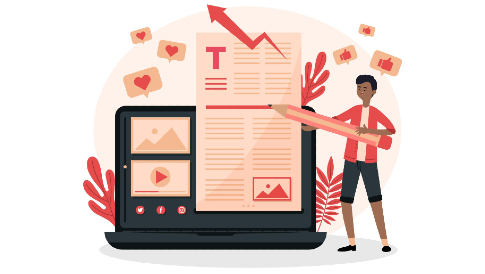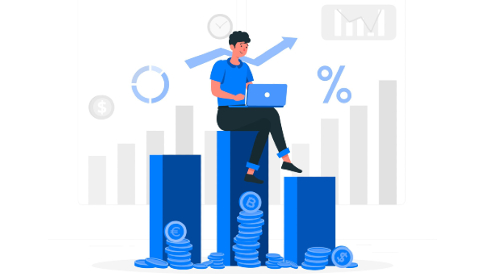How to Increase Time on Site and Make People Stay
Do you know how long visitors stay on your website before closing out or going back to where they came from? Do you realize how much this could be hurting your business? Want to know how to increase time on site on a click? You are in the right place, because today we are going to show you the top reasons why people don`t stay on your website and how to get a good average time on site.

If you are dealing with haunting website bounce rates and aren’t sure why, it’s time that you figure it out. The bounce rate could be low because your website is of low quality, because the visitor can’t find what they’re looking for easily enough, or because they’ve already found the information that they need and are moving on.
It’s been shown before that visitors are likely to stay for less than one minute on every page that they land on, but it’s clear that you’ve got an urgent problem if they are staying for 10 seconds or less. This isn’t even enough time to take in much of your page, so what’s the problem?
Why is it that visitors are leaving so quickly, and what can you do about it and how to increase time on site?
Reason #1: Cluttered Main Page & Landing Pages

When the designs of your main page and landing pages are cluttered, it’s likely that you will have a higher bounce rate than you want to have.
Cluttered pages make it difficult for visitors to identify whether or not you have anything of value to offer them. While their eyes might scan up to a quarter of what you have on the page, it’s less likely that their eyes will catch anything interesting than they might if things were spaced out more clearly.
It’s tough to hear, but you need to know that visitors are not reading your content. They are scanning it. Their eyes and brains are running over the content to decide if there is anything worth reading deeper into, and you might not be passing the test because of a poor website layout.
How to Increase Time on Site
It’s time for a website redesign.
Analyze what you 100% need people to see on a page when they first land on it. What is most important? According to your site goals, what matters most for them to see?
Anything that falls into those categories needs to be at the very top of your page and within the first two paragraphs. Using techniques like subheadings and bullet points to make essential information stand out quickly works well.
If there is another information that you believe will help convert to a sale for those that stay on your page past the initial 10 seconds, feel free to move these things below the fold. “The fold” is the end of what can be read on a page without needing to scroll.
Keep the clutter out of everything above the fold, and move secondary information to a below the fold section, which can then be experienced by the visitors that you convinced to stay.
Reason #2: Broken or Missing Navigation Links

Let’s assume that someone finds their way to your website via an internet search. They’ve come looking for information about your products, and their search has told them that your website might be able to help.
When they land on your pages, however, they see nothing but a wall of text and a jumbled sidebar. Persisting, they attempt to click a link that they believe might help them, but the link redirects them to a broken link page.
Tired of looking, this visitor is likely to leave your site.
Do you see what the problem was?
When your main page or landing pages do not have clear navigation sections and internal linking, your visitor is unlikely to find what they are looking for. This point goes hand-in-hand with reason #1 why people don’t stay on your website for more than 10 seconds: It is disorganized!
- Intuitive
- Descriptive
- Straightforward
Without organization, you are asking your visitors to find a needle in a haystack. Instead, you should be presenting a needle to them on a silver platter.
How to Increase Time on Site
Analyze the navigation tools and bars on your site to find the way how to increase time on site. Run some tests to see where people are dead-ending most frequently, and check for broken links weekly so that you don’t lose visitors unnecessarily.
Then, reimagine how you should help your website flow better. Consider the intent of each visitor as they get to your website:
- What are they looking for?
- What can you offer them?
- Can they easily find their way to it?
Redesign the website’s main navigation features with this in mind. Most important, have a well-placed and properly rigged search bar. When in doubt of where to click, most people will happily search for what they are looking for!
Reason #3: Your Page is Too Slow
In a world of fast-approaching 5G internet on our phones and super fast network connections, no one is patient enough to wait for your website to load unless they know that it is really, really good. If your site is taking more than a couple of seconds to load, that is too long. Your speed (or lack thereof) is causing you to lose visitors. 40% of visitors will leave your website within 3 seconds if it is not loading properly.
Having a slow site doesn’t just scare visitors away, but it can actually keep visitors from ever finding you in the first place! It’s been shown that some search algorithms take loading speed into account. That’s just another reason that it’s time to optimize your website’s speed.
How to Increase Time on Site
One of the simplest ways to speed up your website is to upgrade your hosting, but there’s a wide range of reasons that your website might be running slower than you expect it to:
- Slow web hosting
- Too many plugins
- Database organization issues
- Poor server performance
- Messy code density
- High traffic
- Improper file formats
- Outdated management tools
- Images are not optimized for web
Each of these things (and really, many more items!) can cause your load times to plummet. When load times are dropping, it’s likely that your bounce rate will be getting worse as well, so it’s important that you address these issues.
If you’re experiencing these issues, running a speed diagnostic test can help you to analyze where the page is getting stuck loading and how to efficiently address the problem.
Reason #4: Immediate Popups
A well-placed popup can increase sales; that much has been proven.
But a popup that comes too soon, one that comes before the visitor is sure that they want to browse your website, is more likely to cause them to leave than to convert their visit into a sale.
When you have popups that happen right when a user lands on your page, they’re going to feel bombarded and uncomfortable. Even if the content is good, they’re unlikely to pay attention to it. In a sense, you’ll be wasting both their visit and your great content.
How to Increase Time on Site
If you have a popup of worthy content that you believe can help funnel visitors to become buyers or clients, that’s great! Consider when exactly that content will be most relevant to them.
Is it right when they get to your page before they know anything about you? Or is it after they’ve taken the time to read your page for 30 seconds or even a minute?
We can tell you this: It’s the latter.
Using popups effectively in today’s online world means using popups sparingly and at a delay. Rather than setting up dozens of popups, which bombard visitors the second they reach your page, set up a delayed popup that appears when they reach a certain time in their visit or a certain point on the page.
You’ll find that the funnel is much more effective when the popup doesn’t immediately send visitors packing!
Reason #5: Registration Attacks

This problem is very similar to reason #4, and you’ll see why soon.
Have you ever been on a website that asks you if you would like to register as soon as you get there before you have even had a chance to read the content that you were looking for? Did you feel good about the idea of signing up?
The chances are high that your answer is “no.”
Most people don’t want to give their information to a website simply because they are on it. If the website proves to have some value that they would like to have more of and return to regularly, that’s a different story.
It’s no secret why websites push for early registration. It’s a key part of gaining users, retaining them through email, and pushing sales. Regardless, it has to be handled with care.
How to Increase Time on Site
The solution to this registration problem is very similar to how you should be handling popups on your website: with a delay.
Unless your site implements a paid firewall around the content that the visitor is trying to get to, do not ask them to register before they have even seen the content. Instead, use well-placed call-to-actions within the content itself and appealing registration benefits to the new and regular visitors on your site.
Flashing a registration button in a brand-new visitor’s face isn’t an effective way to keep visitors on your site (or, for that matter, to get them to return). Think more logically about how to incorporate registration tactics.
Reason #6: Text Issues

More than the words that your website has, the font and text style that they are written in can also cause visitors to leave your page before they’ve even learned what you have to offer them.
Common mistakes when it comes to font, text, and style management include:
- Contrast issues: cannot read text easily because of background color or images
- Font choice: unappealing or unprofessional font style that is used extensively
- Multiple fonts: every section has a different font type, making it hard to read
- Misaligned paragraphs: without proper formatting, text might be hard to read or hidden due to alignment problems
If you’ve ever noticed any of these things on your site and thought that visitors can still manage to read despite these issues, then you have a problem.
Any new visitor to your site is not going to want to work to read what you have to say. If you aren’t making the information and value that you have to offer easy for them to read, why should they bother trying to read it?
How to Increase Time on Site
Show that you have pride in all of the content, offers, and advice that you have to offer on your website by offering it in the most readable manner possible.
Keep text color, style, and typeface consistent throughout all of your pages. Do not use hard-to-read contrasting colors. Avoid unprofessional fonts, and remember that your site will appear differently on different screens & browsers; be sure that your site’s text will be viewable across them all. Which brings us to Reason #7…
Reason #7: Compatibility Issues
The average website visitor in today’s internet age is likely to use at least two different devices to access the internet daily. Within those devices, they could be using three or four different browsing methods from mobile browsers to streamlined apps.
Is your website ready to address the compatibility needs of all of those devices?
Some websites become impossible to read, view, or scroll on whenever they cross browsers or devices. If a visitor makes it to one of these websites, there’s always going to be a possibility that they will leave immediately rather than try to make it work.
Unless using your specific website is paramount to their needs, they’ll go elsewhere, and you’ll miss out.
How to Increase Time on Site
Run a compatibility check on your website to find out whether or not your website can cross platforms & browsers without becoming unreadable. By analyzing your site’s analytics, you can find out if a higher percentage of visitors are leaving when on a certain type of device or browser.
Use this information to focus your compatibility efforts. What goes wrong on these devices, and how can you fix it? By optimizing your site to work across as many viewing methods as possible, you’ll be improving your bounce rate.
Reason #8: Attracting The Wrong Audience
If a visitor doesn’t like or care about what is on your website, they will leave quickly. That’s just a fact. A large portion of visitors that make up your bounce rate issue set may have even left for that reason.
So, what’s the problem? They’re allowed not to like the content, right? Of course!
But what that means is that you are somehow bringing in a large number of visitors that are misaligned to your goals. In a way, you are attracting the wrong type of traffic. Once you suspect that this might be a problem on your website, it is time to analyze your traffic generation funnel and find out where things go wrong.
How to Increase Time on Site
If you work with an SEO company to help bring in traffic, consult with them about where they are linking traffic in from. Ensure that they know who your target audience is, and work together to eliminate irrelevant website linking. There is no reason that you should be paying for irrelevant traffic!
When you are advertising, make sure that you laser focus in on the appropriate keywords. For example, advertising “Granny Smith apples” rather than just “apples” would help you find a more relevant audience.
If you manage your SEO yourself, do a thorough audit of the content on your pages and increase the presence of long tail keywords. These keywords help to more effectively filter the types of searches that you will show up in. Eventually, this will help tailor the visitors on your site to be more specific to what you actually provide.
These are just some of the most basic ways that you can make sure that your incoming traffic has the potential to be interested in your content. If you continue to have this problem after doing some auditing and adjustment, it might be possible that your target audience isn’t what you think they are!
Reason #9: Outdated Content

Even if you aren’t posting daily, visitors are likely to click away if your “news” or similarly time-sensitive section is full of week-old content that they have seen time and time again. When it comes to visitors, oversaturated and aging content can quickly send them away.
How to Increase Time on Site
It’s good to have evergreen content that will always be fresh on your site, but it’s important to keep updated content flowing. Posting new content and making relevant changes to your site’s navigation, content, and layout is necessary and important for keeping your site fresh and relevant.
Not only will visitors be more likely to stay if something new and exciting catches their eye, but the search engines might be a little friendlier to you as well.
How to Increase Time on Site and Reduce Bounce Rate – Final Words
This list of reasons is in no way an exhaustive list of the reasons that someone might leave your page in 10 seconds, but making the improvements mentioned here can help to remedy dozens of problems that might be ruining your bounce rates.
Remember that A/B testing and keeping the visitor’s perspective in mind is important when you do analysis work. Don’t just do what you think works. Check the results and try different things until the numbers prove it.
In the end, you’ll see that improved bounce rates affect your entire sales pipeline positively and help you find the answer on how to increase time on site.




Leave a Reply